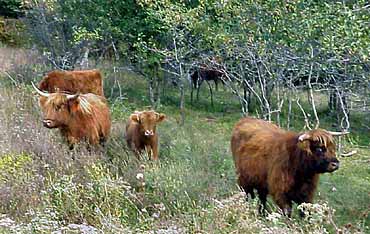Scottish cattle breed tested in southwest Wisconsin
Shaggy horned beasts whose ancestors came from Loch Ness Monster country are now roaming pockets of Wisconsin, creatures with tongues so tough they can swallow almost anything that gets in their way.

Highland cattle come from the mountains of Scotland and thrive on noxious plants. In Wisconsin, their culinary preferences may help restore oak savanna. Photo: courtesy Janet Hedtcke
But these beasties are no bother, because they’re placid vegetarians that just might right the ecosystem imbalance in southwest Wisconsin. They’re part of an experiment led by Martha Rosemeyer, a visiting professor in agronomy.
When Europeans arrived in North America, oak savanna existed at the boundary of the prairies and the eastern forests, featuring widely scattered oaks with an understory of prairie species. It was maintained and renewed by frequent fires and grazing by bison and elk.
Today’s oak savanna has been degraded nearly everywhere in southern Wisconsin, because fire, elk and bison have been taken out of the equation. The result: invasion of the open areas by prickly ash, multiflora rose and blackberry — all of them armored — and woody boxelders that spread fast.
Grazers still abound, but their eating habits are way too picky for the savanna’s good. “Cattle such as Holsteins, Hereford and Angus don’t eat the woody or prickly growth to the extent that bison and elk once did,” says Rosemeyer.
Given the current shortage of bison and elk in Wisconsin, Rosemeyer and colleagues are doing the next best thing: Testing the use of a cattle breed that thrives, not just survives, on noxious plant species.
Highland cattle come originally from the mountains of Scotland. (The stock being used in Rosemeyer’s project were born in the U.S.) The harsh highland environment has produced a breed that needs no shelter in the winter and no human assistance with birthing. Best of all, for Rosemeyer’s purposes, they graze on plants and shrubs that other cattle pass up.
Starting this spring, Highland cattle will be allowed to graze a few days each month on experimental plots at three sites in Iowa and Lafayette counties. Two of them are private farms that already own Highlands, and the third is land-administered by the Department of Natural Resources.
Besides farm owners and DNR officials, the collaboration also involves UW-Extension, UW-Platteville and representatives of UW–Madison, including Rosemeyer and Josh Posner and John Harrington of the Department of Landscape Architecture faculty.
“If this experiment is successful, it will be a win-win solution,” says Rosemeyer. “It will be good for both conservation and production.”
On the production side, Highland cattle offer several attractions to cattle raisers. In addition to being low-maintenance, their meat has only a third of the cholesterol in standard red meat and chicken and very little fat. Both of the farms in the experiment market Highland beef directly to consumers.
Rosemeyer has high hopes that Highland cattle can munch their way through invading plants toward ecosystem health in Iowa and Lafayette counties. Besides, she adds, it’s going to be fun to watch the Highland bulls show what gentlemen they are: They often step on shrubs to bend them down for the cows to eat.
“Chivalry is not dead,” she says.
Tags: research




